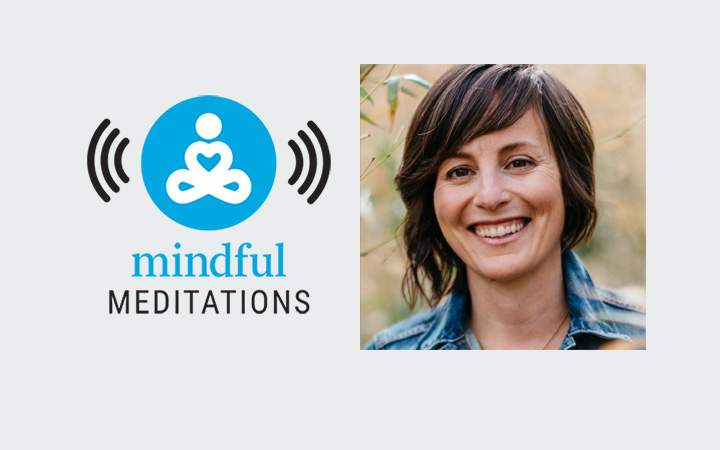Jessica Morey was burned out. The executive director of iBme, Morey was leading a team of six office staff, sixty retreat staff, and about a hundred volunteers, doing work she believed in wholeheartedly—serving mindfulness and meditation practices to teens on summer retreats.
Despite her love for the work, it was stressful. “I was overwhelmed and exhausted,” Morey recalls. And when she looked around at other nonprofits, she saw their executive directors in similar straits. “How are we going to find that person who’s going to do this?” she remembers thinking, of the job that required all the hours and energy she had available to pour into it—and more. “I’m only willing to do this because it’s the center of my heart.” And the situation at work was increasingly uncomfortable.
“When I’m stressed out, I become a general,” Morey says. She narrows her focus to what’s required to survive, and her tone becomes brisk and businesslike, instead of warm and relational. “I probably would be good on a battlefield, but that’s not the paradigm and world I want to live in, actually.” Morey acknowledges that while her staff wanted her to be a loving presence—which she sometimes was—she was just as often disruptive to them. “I could see how I was behaving,” she says now. “I was not aligned with my mindfulness practice values at all.”
A New Way to Work
Frustrated, she was browsing the Animas Valley Institute’s website, thinking perhaps she’d go on a wilderness program. On their “About” page, what she saw rocked her world: “Since 2008, we have structured ourselves as a team-led, service organization with no executive director.”
For Morey, it was a glimpse of a possibility she didn’t know existed. A second glimpse came when her friend Oren Jay Sofer introduced her to Miki Kashtan, who Morey describes as “an intellectual driving force, in human relationship and capacity.” With Kashtan’s help, Morey began to see a way to have the kind of organization she wanted, “a highly effective, but very relational, warm environment.”
Kashtan asked her to start by reading Reinventing Organizations by Frederic Laloux, a groundbreaking book about companies that are using an integrated form of leadership— relying neither on consensus nor on a top-down approach. Laloux calls them “teal” organizations. Morey was fascinated especially by a chapter on budgeting and strategic planning. “A teal organization wouldn’t do long-term budgeting or planning. That scared me a bit—but so did all of it in the beginning, each step of the way.”
And so, in autumn 2016, Morey and iBme began a rigorous process of self-examination and transformation.
Exploring Pain Points and Purpose
Kashtan uses a framework she calls Collaboration in the Workplace to help organizations in addressing five critical systems: feedback, decision-making, conflict engagement, information flow, and resource flow. She began by widely interviewing all of iBme’s office employees, teachers, and other staff, to ask questions like: Where are the biggest pain points? What are your purposes and values?
Because Morey and the organization were so tightly wound up in each other, the process required a deep dive into Morey’s own purposes and values, along with the organization’s, and a process of disentangling the founder from what she had founded.
“It was like spiritual bone-setting,” Morey says. “It was so painful.” There were times she thought she’d break, or the organization would.
“There was a lot of conflict in the organization,” Morey says. “Mostly with me.” Kashtan provided individual coaching to Morey throughout the process, and facilitated conversations between the executive director and employees. “It was like spiritual bone-setting,” Morey says. “It was so painful.” There were times she thought she’d break, or the organization would. But Kashtan was a steady guide, and Morey’s deep mindfulness practice—a constant in her life since childhood—was instrumental as well. “Now, I look back and it’s so much better. I see the pain I was causing, the pain I was in, the delusion, the lack of skill, the way I was controlling out of fear.”
Not an undertaking for the faint of heart. And it comes down to heart for Morey. “I care so much about the organization and its long-term sustainability. I want it to thrive.” And at the same time, for Morey herself, “It was like doing intensive therapy. And I actually enjoy seeing my blind spots, and growing.”
One major blind spot for Morey was power. “I didn’t think of myself as having power or coming from a powerful position in almost any relationship—including with colleagues and staff on retreat. I didn’t attend to the role of the power dynamics in our interactions. This is incredibly common for folks in power and privilege. It’s almost like we don’t want to see our power—but those without power are very clear about the power dynamics and who has it.”
The work was hard and emotional, but ultimately nourishing. “I was learning how to be in line with my own values in profound ways. That was deeply hope-inspiring.”
Jessica Morey, Former iBme Executive Director
Further work allowed Morey to see where she was clinging to control. “I don’t like to think of myself as controlling, but I got to see how in some situations I want things to happen exactly how I want them to happen—and I justify that as the right way, the best way, the obvious way—but it’s really just the way I think and want it to be done.”
The work was hard and emotional, but ultimately nourishing. “I was learning how to be in line with my own values in profound ways. That was deeply hope-inspiring.”
Not every moment of that was enjoyable, however. Kashtan led the group in a process to set up robust and transparent feedback systems. Early in that process, Kashtan facilitated a feedback session between Morey and a retreat staffer. “He had built up three years of resentment toward me,” Morey says, that stemmed from a small incident during a teen retreat where the two differed on how to lead an icebreaker event. “It was a snowball that became an avalanche,” Morey says. “We could have talked about it three years ago; it was not that big a deal.” Instead, Kashtan organized two ninety-minute sessions. “She was like, ‘OK, Jess, you’re going to have to just hold yourself and your own goodness. Hold that while you listen, really openly, to everything he’s going to tell you.’ He’s sitting there, and she says, ‘Jess, you can also know that I hold you with the deepest respect. OK, now let’s go forward.’”
Morey credits her mindfulness practice with helping her stay moored. “Being able to receive really intense, critical feedback, being willing to be in the discomfort, giving and receiving critical feedback, and being able to distinguish what’s my emotion and reactivity versus what’s actually happening in the situation—it was the first time I was deeply able to translate that insight into a human relationship.”
Working in Alignment with Company Values
During this time, there was an almost complete turnover of staff at iBme. Morey was inclined to blame herself at first, but Kashtan pointed out that not everyone wants to work in this deep way, and the staff who left weren’t aligned with the values iBme has, which came to the fore during the feedback training and process. Kashtan spent about half her time in one-on-one coaching of Morey, and the other half training iBme’s staff and community members. The people who stayed, and the new staff who came aboard (the organization now has five core staff members, and is in the process of adding a sixth and seventh, along with about 60 teachers) are better aligned, and, Morey says, they report a ripple effect from this relational way of working. “They’re like, this is improving my whole life. I’m able to have an adult conversation with my wife, or my contractor, that I never would have had if I didn’t have this experience and training.”
Working at iBme in development and communications was Arielle Pierre’s first job right out of college. She began work last spring, and says she can’t imagine working without collaborative leadership principles. She says she uses what she’s learned about feedback in her personal relationships, as well as at work. “Feedback is happening all the time. Even if we don’t call it feedback. People’s actions could be feedback, and even saying I like this or I didn’t like this it’s always happening. People think feedback is a scary, hard, really difficult process, but in reality, it’s really common to our culture already. It’s just that we’re articulating it and formalizing it.”
Care, respect, and trust is necessary organization-wide in order for transformational work to happen.
Feedback was transformational for Morey in an unexpected way. “I can be blind to my own positive power, qualities, and impact, the amount of respect and trust that is there.” This would often lead to her projecting herself negatively in other people’s reactions to her. “When they are actually holding me with much higher regard than I could imagine. It’s part of the habit of low self-esteem. And actually itself causes weird, confusing dynamics. So feedback systems have also shown me the amount of care, respect, and positive impact that is also in the space that I wasn’t aware of.”
That care, respect, and trust is necessary organization-wide in order for this transformational work to happen. And it was key in the next piece that needed overhauling. The decision-making piece is where the nonhierarchical rubber really hits the road. The core staff, including Morey, made a matrix of all the kinds of decisions that need to be made along the side, and every person’s name at the top. Ways of contributing to decisions were plotted out with a numbered system, from One (I want to decide) to Five (I don’t want to be involved at all). “There always has to be a One, and only one One,” Morey says. The team talks through the matrix outcome—ensuring that the self-appointed Ones have the skills, abilities, and capacity to be the decision-maker.
The team revisits the matrix quarterly, and uses it to see where there are gaps in their team that need to be addressed.
Sarah Wrean has been working in programs at iBme since October 2017. She describes the decision-making process as one in which she consults broadly with anyone who might have expertise, or who might be affected by the decision. And while that may result in more work up front, she says it is absolutely freeing. “It’s liberating and it’s transparent to say, I asked for input from these 10 people, they all agreed with my decision, and that’s how I came to make it. And then when something doesn’t go right you can go back and say, ‘Hey, we all thought this was the right decision and it wasn’t. What did we learn?’”
Reimagining Company Values
The work requires the presence and spaciousness that can result from deep practice—and it gives rise to curiosity about the usual benchmarks of corporate health, efficiency among them. “It’s using your resources well towards your goal,” Morey says. “Plants are efficient, ecology is efficient. The question is, What are you being efficient with, and towards what?”
“Collaborative leadership is a way to counteract the power, privilege, and patriarchy that we experience,” Wrean notes. “It’s deliberately deconstructing a sort of top-down system in service to everyone.”
The result is a more humane way of working—and that’s reflected in the values iBme lists on its website, where, Morey says, they made a conscious decision to also list their unexamined
values, or shadow values. “One of our unexamined values is ‘sacrificing warmth in a relationship for productivity.’ Another is ‘valuing growth for growth’s sake,’ and ‘working to a point of the lack of well-being.’” Morey says Kashtan emphasized the importance of acknowledging those values. “Because you keep doing them unless they’re made explicit.”
“Collaborative leadership is a way to counteract the power, privilege, and patriarchy that we experience.”
Sarah Wrean, iBme Programs Lead
Much like a meditation practice, this transformational work is ongoing. “It’s a lot about letting go of control, and building trust in people, but also developing skill sets that are outside of ‘command, control, demand,’” Morey says. “There are other, more pleasant ways to have your needs met.”
Ultimately, Wrean and Pierre say, this way of working results in less conflict. Pierre points to something she learned from Kashtan: “Conflict is feedback not given.” So even though this way of working requires more care and effort, and more openness to giving and receiving feedback than many workplaces do, in the end, it has its own efficiency, because resentments don’t have a chance to build up—and it allows teams to work toward equity.
Leading by Getting Out of the Way
On that front, and with processes in place to fully empower every member of the team, Morey has stepped out of her staff position. “The real instigating moment was George Floyd’s murder and some of the intense conversations with Black teachers, who are giving intense unfiltered feedback,” Morey says. She adds the leadership team recognized that though power has been distributed to the staff and the board, the vast majority of people with power at iBme are white, middle-class cisgender women. Morey stepping aside will make room for a second person of color to join the staff. And the organization has added a Teachers’ Advisory Council made up of seven BIPOC teachers who will choose teaching teams and curriculum, and who control about a tenth of the organization’s overall budget.
These are steps Morey says iBme wouldn’t have been able to take three years ago. “If I had quit I don’t think iBme would still exist—and now staff is like, ‘Yeah, we think you should not do anything for three months. We’re cool.’ There’s just so much more resilience in the system.”
There’s still work to be done with Miki Kashtan. The collaborative leadership team is working on resource flow, starting with a collaborative and transparent compensation system—where compensation decisions will happen at budgeting time, and will not be linked to evaluations. And they’ll need to do some restructuring at the board level. They’ll also be working on information flow and conflict resolution in the years to come.
Morey thinks the organization is in good hands. “I have confidence in the systems to transform people. And I think our practice is at the root of what makes it possible.”
read more
A Q&A with Collaborative Leadership Facilitator Miki Kashtan
Changing the way we work requires open honesty, a cooperative spirit, a willingness to cede control—and, yes, a fearless heart, says Miki Kashtan.
Read More
Build Emotional Resilience with Jessica Morey
In this 4-part series you’ll explore a series of meditations on building emotional resilience, learning how to mindfully practice with anger, anxiety, longing, and joy.
Read More
12 Powerful Women of the Mindfulness Movement: 2020
In our second annual focus on women leaders of mindfulness, twelve women share how their deep practice has shaped the world they see—and the one they’re working toward.
Read More
10 Guided Meditations from the Powerful Women of the Mindfulness Movement
As we celebrate the women leaders of mindfulness, we invited teachers, researchers, and activists to share guided meditations that reflect what they’ve learned from their years of deep practice.
Read More









